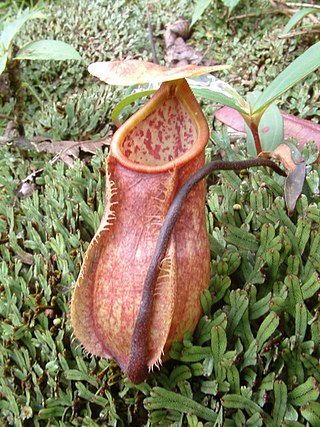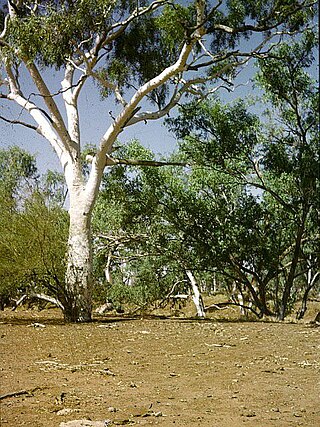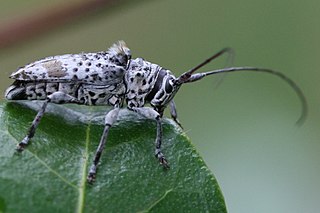
Papuacedrus papuana is a species in the conifer family Cupressaceae, the sole species in the genus Papuacedrus. Some botanists do not consider this species as forming a distinct genus, but include it in the related genus Libocedrus. It is native to New Guinea and to the Indonesian Province of Maluku.

Nepenthes neoguineensis is a tropical pitcher plant native to the island of New Guinea, after which it is named.

Nepenthes papuana is a tropical pitcher plant endemic to New Guinea. The specific epithet papuana is derived from Papua, an alternative name for the island.

Apodora papuana is a species of python, commonly known as the Papuan python, Irian python or Papuan olive python. It is found in New Guinea. It is the only species in the genus Apodora. No subspecies are currently recognized.

The canary flyrobin, also known as the Papuan flycatcher, canary robin, canary flycatcher, or montane flycatcher, is a species of bird in the family Petroicidae. It is found in New Guinea. Its natural habitat is subtropical or tropical moist montane forests with elevations from 1,100–3,500 m (3,609–11,483 ft). Currently, its population is believed to be stable.

Corymbia papuana, commonly known as ghost gum, is a species of evergreen tree native to New Guinea, some Torres Strait Islands and the northern part of the Cape York Peninsula in Australia. It has smooth whitish bark, lance-shaped adult leaves, flower buds in groups of three or seven, creamy white flowers and barrel-shaped or urn-shaped fruit.
Citrus wintersii, the Brown River finger lime, is a shrub native to the Brown River region in Papua-New Guinea. It was previously known as Microcitrus papuana. It has, as the "finger" name suggests, a small, thin fruit, pointed at both ends. It grows near Port Moresby.

Disterna is a genus of longhorn beetles of the subfamily Lamiinae.
Disterna bifasciata is a species of beetle in the family Cerambycidae. It was described by Francis Polkinghorne Pascoe in 1859. It is known from Australia.

Disterna plumifera is a species of beetle in the family Cerambycidae. It was described by Francis Polkinghorne Pascoe in 1859. It is known from Australia.
Disterna tasmaniensis is a species of beetle in the family Cerambycidae. It was described by Stephan von Breuning in 1982. It is known from Tasmania.
Disterna spinipennis is a species of beetle in the family Cerambycidae. It was described by Stephan von Breuning in 1960. It is known from Australia.
Disterna annulata is a species of beetle in the family Cerambycidae. It was described by Stephan von Breuning in 1939. It is known from Australia.
Disterna ovalis is a species of beetle in the family Cerambycidae. It was described by Breuning in 1939. It is known from Australia.
Disterna complexa is a species of beetle in the family Cerambycidae. It was described by Francis Polkinghorne Pascoe in 1859. It is known from Papua New Guinea.
Disterna luctuosa is a species of beetle in the family Cerambycidae. It was described by Francis Polkinghorne Pascoe in 1862. It is known from Australia.
Disterna canosa is a species of beetle in the family Cerambycidae. It was described by Wilhelm Ferdinand Erichson in 1842. It is known from Australia including Tasmania.
Disterna mastersii is a species of beetle in the family Cerambycidae. It was described by Francis Polkinghorne Pascoe in 1871. It is known from Australia.
Disterna atrofasciculata is a species of beetle in the family Cerambycidae. It was described by Per Olof Christopher Aurivillius in 1916. It is known from Papua New Guinea.
Disterna maculata is a species of beetle in the family Cerambycidae. It was described by Keith Collingwood McKeown in 1938. It is known from Australia.







